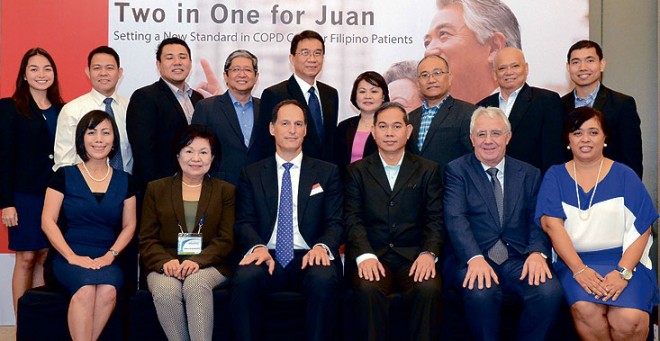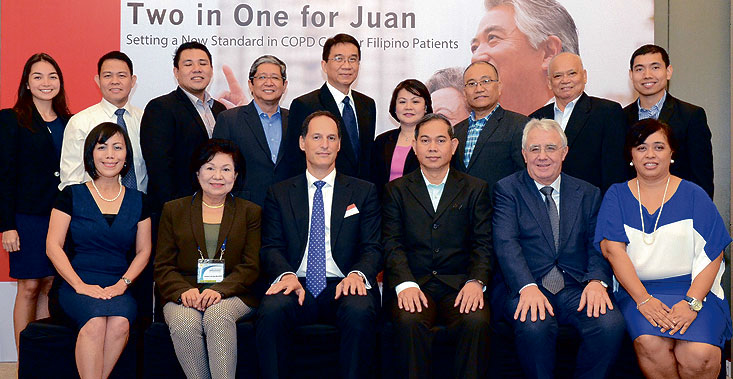
The toughest, most stubborn patients are doctors. Former medical director of the University of the Philippines-Philippine General Hospital and chronic obstructive pulmonary disease (COPD) patient, Dr. Napoleon Apolinario, is not an exception.
When he started coughing and wheezing and running out of breath, Apolinario refused to seek professional help, performed a self-diagnosis, and dismissed the discomfort as nothing more than “a little asthma.”
“It gradually became full-blown COPD just when I was riding the crest of my career. I was a surgeon and a hospital administrator, but I was already feeling that I could drop dead any time.
“I couldn’t finish a sentence without coughing. I couldn’t dance anymore without feeling like collapsing. Pakiramdam ko isang bulate na lang ang hindi nakakapirma sa aking death certificate,” Apolinario said.
In September last year, he experienced the worst episode of incessant coughing, difficulty in breathing, tiring so easily, and choking each time he ate anything. He had lost hope, he said, until he read an Oct. 14 article about glycopyrronium bromide (Seebri).
“I will never forget that date. It became the turning point of my life. Having COPD is a lifelong challenge but it need not be a lifelong penance for the excesses in our younger years,” he said.
After taking the drug, he said he began to breathe better, cough less, and feel more energized.
Alarming figures
More than 17 million Filipinos (28.3 percent) aged 15 years and older are currently smokers. Of that number, 47.7 percent are men and 9 percent are women. The majority of deaths attributed to smoking are caused by COPD and cerebrovascular diseases. COPD is the sixth leading cause of death in the Philippines and is projected to be the third leading cause of death worldwide by 2020.
“What is COPD? Chronic means it won’t go away, obstructive means the air passages are blocked, pulmonary means that the lungs are affected, and disease means it’s a sickness. The subtypes of COPD are chronic bronchitis and emphysema. So if a person died of emphysema it means he died of COPD,” said Dr. Tim Trinidad, chair of the Council of COPD and Pulmonary Rehabilitation.
Trinidad said that the burden of COPD in Metro Manila is 14 percent, while two towns in Nueva Ecija had a prevalence rate of 21 percent. Aside from the high prevalence rate, only 2 percent of the cases were diagnosed by doctors and up to 19 percent do not know they have COPD.
The high prevalence rate and underdiagnosis of COPD, he said, is mainly caused by society’s misconception of its early symptoms and the apparent lack of diagnostic skills by many medical practitioners.
One myth, he said, is attributing shortness of breath to old age. Many think that if they rest, the shortness of breath will go away. And it will—at the start. COPD is a progressive disease. It is initially “silent,” attacking the lungs gradually.
“We have a large respiratory reserve function. Life is actually compatible even with just one lung. If 20 percent of the lung function is destroyed, the patient doesn’t feel anything. A patient will only begin to feel something when 50-80 percent of the lung capacity has been compromised,” Trinidad said.
Another misconception, he said, is that COPD is not treatable. Trinidad said there are now powerful pharmacologic and nonpharmacologic agents that are going to improve the symptoms of patients, improve their quality life, and perhaps reduce the complications of COPD.
Proper dissemination
To aid doctors in diagnosing, Trinidad said there must be a dissemination of practice guidelines to medical practitioners in the country. “If undertreatment of COPD in the US is 65 percent, then you can imagine how undertreatment is in our country,” he said.
But who are at risk and how do we identify them?
“If you’re coughing several times a day; if you have phlegm or mucus three times a year for two consecutive years; if you feel out of breath easily when you’re going out with people of the same age; if you are 40 and above; if you have smoked at some point in your life; and if you have answered ‘yes’ to three of these questions, see a pulmonologist,” said Dr. Teresita de Guia, national leader of the Global Initiative for Chronic Obstructive Lung Disease.
Smokers are at risk of developing COPD, although only 15-20 percent have it. Other risk factors include genetics and environmental exposure to chemicals, fumes and dust.
The first once-daily dual bronchodilator is now available in all major drugstores in the country for adult patients with COPD.














































